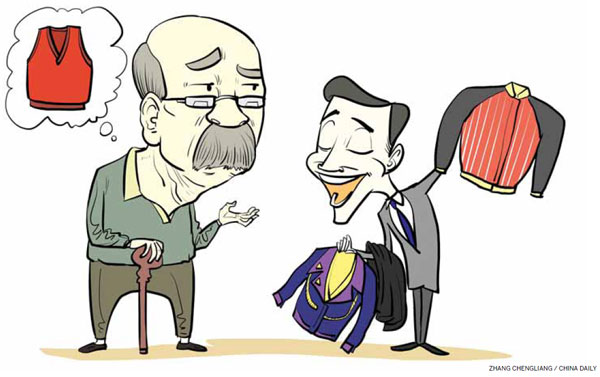How to tap into China's gray market
Updated: 2013-08-09 09:22
By Mike Bastin (China Daily)
|
|||||||||||


The aging population presents exciting potential for well-informed manufacturers and retailers
Despite the recent slowdown in China's economy, many foreign companies continue to see the world's second-largest economy as one of the most attractive markets now and in the future. Consumption of foreign brands by Chinese consumers contributes considerably to the profits of many foreign companies, especially luxury brand producers. But do foreign companies and their marketing teams really understand the changing nature of China's consumer base?
Much discussion has taken place about the younger generations, especially those born after the commencement of China's family planning policy in the late 1970s. Marketing to China's younger and more modern consumer base continues to receive a lot of attention. Both the reform and opening-up policy and the family planning policy have clearly spawned a generation of different and heavy brand consumers. But what appears to have been overlooked by many foreign companies operating across the Chinese mainland, the great majority of which target the 18-35 age group, is the aging impact of these policies.
According to China's central government, the family planning policy is responsible for the reduction of more than 250 million births between 1979 and 2000. While the overall population continues to grow, the growth rate has fallen and is estimated to fall below 0.5 percent a year by 2017. Furthermore, the United Nations predicts that the population will stop growing entirely by 2032 and will then start to shrink. If current trends continue, by 2028 India will become the world's most populous country.
Foreign companies, especially those which continue to target only younger urban professionals, appear to be ignorant not just of China's aging population but the acceleration of this as a result of the family planning policy.
China's demographic make-up will change and soon. It will resemble less and less the age distribution found in other similarly developing nations such as neighboring India. Foreign companies, therefore, will need to re-evaluate their product and brand portfolios very carefully.
The market size and growth rate of the younger, typically 18-35 age group, will prove less and less attractive and will be soon outnumbered by China's aging generations.
It is estimated that by about 2038 there will be as many people over the age of 65 in China as there will be under the age of 20. Moreover, post-2038, older consumers will outnumber younger ones.
Foreign companies and their marketers who can gain an understanding of the lifestyles and buyer behavior of these older generations should do well. But simply extending their product and brand portfolios with similar positioning and marketing will lead to failure. Though many of China's senior citizens consume many of the brands desired by their younger counterparts, it is estimated that only 10 percent of these products are actually targeted directly at older generations. There is huge potential, therefore, for foreign companies.
So, how to tap into this vast and growing demographic group?
Positioning is crucial. Older Chinese consumers remain "traditional" in comparison with the modernity of China's youth. Such traditional values should lead to brands positioned as "nostalgic" and "nationalistic", supported by marketing and advertising campaigns which aim to portray China's rich culture and history.
However, my consumer research confirms that, while older generations remain more traditional - that is, nationalistic and respectful of the past - they also share the desire for fun, adventure and excitement that motivates much of the younger generations' consumption behavior.
It is, therefore, a careful fusion of these traditional and modern values, with the traditional at the fore, which should appeal to China's gray market. A subtle shift in favor of traditionalism is, therefore, necessary to position the very same brand successfully in the minds of this older group in comparison with China's 18-35-year-olds.
To achieve such a successful fusion, implementation of the dual or double brand name strategy often employed successfully in China, and elsewhere, will be helpful.
Two brand names are presented to the market here, one often the corporate brand name. Lenovo's Thinkpad and Mengniu's Telunsu are current examples.
For older generations, the corporate brand name should dominate (source branding), and evoke the traditional values discussed earlier. But at the same time, a more modern, fresh and exciting product name is also important as older people move toward emotional consumption and a varied lifestyle. For younger generations, the product brand name resonates more, while the corporate brand name remains an important endorsement (endorsement branding).
While similarities in consumption across China's population, such as the need for excitement and fun, require similar marketing approaches, key differences necessitate significant alterations.
Consumers looking for variety are common among China's young adult market, while older consumers remain content with making purchases over a longer period and are not attracted simply by new products and services. As a result, lifetime product value will prove far more effective in any brand positioning and advertising campaigns aimed at older buyers.
Pricing policy should reflect this "lifetime value" theme, where the initial price is less important than the expected lifetime of the product. Prices may remain similar across generations, but for older people a higher-priced product should be positioned as reliable and effective in the long term. For younger generations the very same price may work, but only if it is positioned as a reflection of status, success and power.
The fusion of traditional and modern values should also be reflected in the product's appearance and packaging. Conservative, neutral colors should dominate but a hint of brighter, younger, even garish, colors should be included.
Perhaps the greatest challenge of all lies in reaching these aging consumers. Urban China and urbanisation across the country create difficulties in distribution and delivery. It is estimated that about 20 million rural inhabitants move to China's cities each year.
Aging consumers will, therefore, find buying by traditional retail channels increasingly unattractive. However, another surprise finding among my recent research is the apparent ease with which older Chinese consumers adopt new technology. This generation appears just as conversant with the Internet and e-retailing as any other.
E-commerce is, therefore, a major vehicle for reaching these older consumers who value very highly the convenience and comfort of armchair shopping. It should be noted that e-commerce not only presents an efficient means of communication and distribution but also enables the development of long-term, emotional relationships. Older generations will not be swayed as much as their younger counterparts by associations such as celebrity endorsements, but could move up the ladder of loyalty from initial purchase to the most loyal customer with regular, direct contact. E-commerce should, therefore, not just be used to reach and sell efficiently but should be seen as the major communication method for effective, personalized dialogue with older customers.
Foreign companies still have an advantage over their domestic rivals, but while this lasts their product and brand portfolios must reflect the differing needs of age groups across China's distinctive demographic spread.
It may be that Chinese consumers currently older than 65 constitute just less than 10 percent of today's population, but this is forecast to increase to about 25 percent by 2040. A market of some 350 million, and growing, is worthy of detailed attention.
Foreign companies operating in China should measure success not just by overall market share and the usual financial indicators. Their sales, market share and customer satisfaction ratings among China's aging consumer base are critical to their sustained success in China.
The author is a visiting professor at the University of International Business and Economics in Beijing and a researcher at Nottingham University's School of Contemporary Chinese Studies. The views do not necessarily reflect those of China Daily.
(China Daily European Weekly 08/09/2013 page10)
Today's Top News
List of approved GM food clarified
ID checks for express deliveries in Guangdong
Govt to expand elderly care
University asks freshmen to sign suicide disclaimer
Tibet gears up for new climbing season
Media asked to promote Sino-Indian ties
Shots fired at Washington Navy Yard
Minimum growth rate set at 7%
Hot Topics
Lunar probe , China growth forecasts, Emission rules get tougher, China seen through 'colored lens', International board,
Editor's Picks

|

|

|

|

|

|





